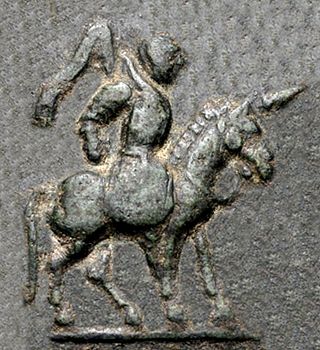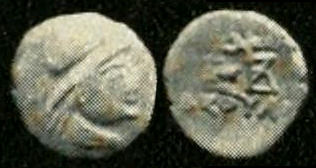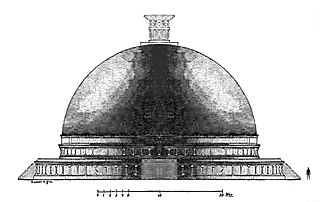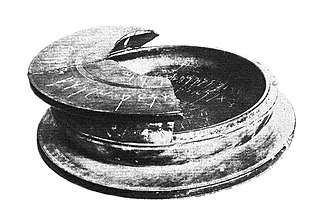
Indo-Scythians were a group of nomadic Iranian peoples of Scythian origin who migrated from Central Asia southward into the northwestern Indian subcontinent, precisely into the modern-day South Asian regions of Afghanistan, Pakistan and northern India. The migrations persisted from the middle of the 2nd century BCE to the 4th century CE.

Maues was the first Indo-Scythian king, ruling from 98/85 to 60/57 BCE. He invaded India and established Saka hegemony by conquering Indo-Greek territories.

The Kanishka casket or Kanishka reliquary, is a Buddhist reliquary made in gilded copper, and dated to the first year of the reign of the Kushan emperor Kanishka, in 127 CE. It is now in the Peshawar Museum in the historic city of Peshawar, Pakistan.

Rajuvula was an Indo-Scythian Great Satrap (Mahākṣatrapa), one of the "Northern Satraps" who ruled in the area of Mathura in the northern Indian Subcontinent in the years around 10 CE. The Mathura lion capital was consecrated under the reign of Rajuvula. In central India, the Indo-Scythians had conquered the area of Mathura from Indian kings around 60 BCE. Some of their satraps were Hagamasha and Hagana, who were in turn followed by Rajuvula.
Theodorus was a "meridarch" in the Swat province of the Indo-Greek kingdom in the northern Indian subcontinent, probably sometime between 100 BCE and the end of Greek rule in Gandhara in 55 BCE.

The Bimaran casket or Bimaran reliquary is a small gold reliquary for Buddhist relics that was removed from inside the stupa no.2 at Bimaran, near Jalalabad in eastern Afghanistan.

The Mathura lion capital is an Indo-Scythian sandstone capital from Mathura in Northern India, dated to the first decade of the 1st century CE. It was consecrated under the rule of Rajuvula, one of the Northern Satraps of the region of Mathura.

Sodasa was an Indo-Scythian Northern Satrap and ruler of Mathura during the later part of the 1st century BCE or the early part of 1st century CE. He was the son of Rajuvula, the Great Satrap of the region from Taxila to Mathura. He is mentioned in the Mathura lion capital.

Liaka Kusulaka was an Indo-Scythian satrap of the area of Chukhsa in northwestern India during the 1st century BCE.

The Bajaur casket, also called the Indravarma reliquary, year 63, or sometimes referred to as the Avaca inscription, is an ancient reliquary from the area of Bajaur in ancient Gandhara, in the present-day Federally Administered Tribal Areas of Pakistan. It is dated to around 5–6 CE. It proves the involvement of the Scythian kings of the Apraca, in particular King Indravarman, in Buddhism. The casket is made of schist.

The Silver Reliquary of Indravarman is an inscribed silver Buddhist reliquary dedicated by Apracaraja king Indravarman in the 1st century BCE, which has been found presumably in the Bajaur area of Gandhara. Believed to have been fabricated at Taxila, the silver reliquary consists of two parts—the base and the cover—both being fluted, and the cover being topped by a figure of long horned Ibex. It has been dated to around the eighth or ninth decades of the 1st century BCE and bears six inscriptions written in pointillē style, in Kharoshthi script and Gandhari/north-western Prakrit. In form, the silver vessel is wholly atypical of Buddhist reliquaries and is said to have been a wine goblet, similar to others found in Gandhara and Kapisa regions. The vessel was later reused by Apraca king Indravarman as a Reliquary to enshrine Buddhist relics in a stüpa raised by Indravarman. The inscriptions on the silver reliquary provide important new information not only about the history of the kings of Apraca dynasty themselves but also about their relationships with other rulers of the far north-western region of traditional India i.e. modern northern Pakistan and eastern Afghanistan around the beginning of Christian era.
Patika Kusulaka was an Indo-Scythian satrap in the northwestern South Asia during the 1st century BCE.

The Wardak Vase is an ancient globular-shaped buddhist copper vase that was found as part of a stupa relic deposit in the early nineteenth century in the Wardak Province of Afghanistan. The importance of the vase lies in the long Kharoshthi inscription which dates the objects to around 178 AD and claims that the stupa contained the sacred relics of the Buddha. Since 1880, the vase has been part of the British Museum's Asian collection.
The Northern Satraps, or sometimes Satraps of Mathura, or Northern Sakas, are a dynasty of Indo-Scythian rulers who held sway over the area of Punjab and Mathura after the decline of the Indo-Greeks, from the end of the 1st century BCE to the 2nd century CE. They are called "Northern Satraps" in modern historiography to differentiate them from the "Western Satraps", who ruled in Sindh, Gujarat and Malwa at roughly the same time and until the 4th century CE. They are thought to have replaced the last of the Indo-Greek kings in the Punjab region, as well as the Mitra dynasty and the Datta dynasty of local Indian rulers in Mathura.

Indravarman or Indravarma, also called Itravasu on his coinage, was an Indo-Scythian king of the Apracas, who ruled in the area of Bajaur in modern northwestern Pakistan. He was the son of Vispavarma. Indravarma had a son, Aspavarma, commander and later king, known from an inscription discovered at Taxila. Aspavarma also mentioned his father Indravarma on some of his coins.
Indravasu was an Indo-Scythian king of the Apracas in Bajaur, western Pakistan.
The Rukhuna reliquary, also sometimes Rukhana reliquary, also described as the Bajaur reliquary inscription, is a Scythian reliquary which was dedicated and inscribed in 16 CE by Rukhuna, Queen of Indo-Scythian king Vijayamitra. The inscription on the reliquary, also called the Bajaur reliquary inscription, was published by Richard Salomon with a photograph in 2005, and gives a relationship between several eras of the period, and especially a confirmation of a Yavana era in relation to the Azes era, that is "Azes era= Yavana era - 128 years".

The Manikyala Stupa is a Buddhist stupa near the village of Tope Mankiala, in the Pothohar region of Pakistan's Punjab province. The stupa was built to commemorate the spot, where according to the Jataka tales, an incarnation of the Buddha called Prince Sattva sacrificed himself to feed seven hungry tiger cubs.

The Shinkot casket, also Bajaur reliquary of the reign of Menander, is a Buddhist reliquary from the Bajaur area in Gandhara, thought to mention the reign of the 2nd century BCE Indo-Greek king Menander I. The steatite casket is said to have contained a silver and a gold reliquary at the time of discovery, but they have been lost.

Indo-Scythian art developed under the various dynasties of Indo-Scythian rulers in northwestern India, from the 1st century BCE to the early 5th century CE, encompassing the productions of the early Indo-Scythians, the Northern Satraps and the Western Satraps. It follows the development of Indo-Greek art in northwestern India. The Scythians in India were ultimately replaced by the Kushan Empire and the Gupta Empire, whose art form appear in Kushan art and Gupta art.















